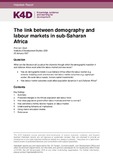| dc.contributor.author | Quak, Evert-jan | |
| dc.coverage.spatial | Sub-Saharan Africa | en |
| dc.date.accessioned | 2021-01-28T18:25:34Z | |
| dc.date.available | 2021-01-28T18:25:34Z | |
| dc.date.issued | 2021-01-20 | |
| dc.identifier.citation | Quak, E. (2021). The link between demography and labour markets in sub-Saharan Africa. K4D Helpdesk Report No.911. Brighton, UK: Institute of Development Studies. DOI: 10.19088/K4D.2021.011 | en |
| dc.identifier.uri | https://opendocs.ids.ac.uk/opendocs/handle/20.500.12413/15931 | |
| dc.description.abstract | This rapid review synthesises the literature from academic, policy, and knowledge institution sources on how demography affects labour markets (e.g. entrants, including youth and women) and labour market outcomes (e.g. capital-per-worker, life-cycle labour supply, human capital investments) in the context of sub-Saharan Africa. One of the key findings is that the fast-growing population in sub-Saharan Africa is likely to affect the ability to get productive jobs and in turn economic growth. This normally happens when workers move from traditional (low productivity agriculture and household businesses) sectors into higher productivity sectors in manufacturing and services. In theory the literature shows that lower dependency ratios (share of the non-working age population) should increase output per capita if labour force participation rates among the working age population remain unchanged. If output per worker stays constant, then a decline in dependency ratio would lead to a rise in income per capita. Macro simulation models for sub-Saharan Africa estimate that capital per worker will remain low due to consistently low savings for at least the next decades, even in the low fertility scenario. Sub-Saharan African countries seem too poor for a quick rise in savings. As such, it is unlikely that a lower dependency ratio will initiate a dramatic increase in labour productivity. The literature notes the gender implications on labour markets. Most women combine unpaid care for children with informal and low productive work in agriculture or family enterprises. Large family sizes reduce their productive labour years significantly, estimated at a reduction of 1.9 years of productive participation per woman for each child, that complicates their move into more productive work (if available). If the transition from high fertility to low fertility is permanent and can be established in a relatively short-term period, there are long-run effects on female labour participation, and the gains in income per capita will be permanent. As such from the literature it is clear that the effect of higher female wages on female labour participation works to a large extent through reductions in fertility. | en |
| dc.description.sponsorship | FCDO (Foreign, Commonwealth and Development Office) | en |
| dc.language.iso | en | en |
| dc.publisher | Institute of Development Studies | en |
| dc.relation.ispartofseries | K4D Helpdesk Report;911 | |
| dc.rights.uri | https://www.nationalarchives.gov.uk/doc/open-government-licence/version/3/ | en |
| dc.subject | Population | en |
| dc.subject | Rights | en |
| dc.subject | Work and Labour | en |
| dc.title | The Link Between Demography and Labour Markets in sub-Saharan Africa | en |
| dc.type | Helpdesk | en |
| dc.rights.holder | © Crown copyright 2021 | en |
| dc.identifier.doi | 10.19088/K4D.2021.011 | |
| dcterms.dateAccepted | 2021-01-20 | |
| rioxxterms.funder | Department for International Development, UK Government | en |
| rioxxterms.identifier.project | K4D | en |
| rioxxterms.version | VoR | en |
| rioxxterms.versionofrecord | 10.19088/K4D.2021.011 | en |
| rioxxterms.funder.project | 238a9fa4-fe4a-4380-996b-995f33607ba0 | en |

